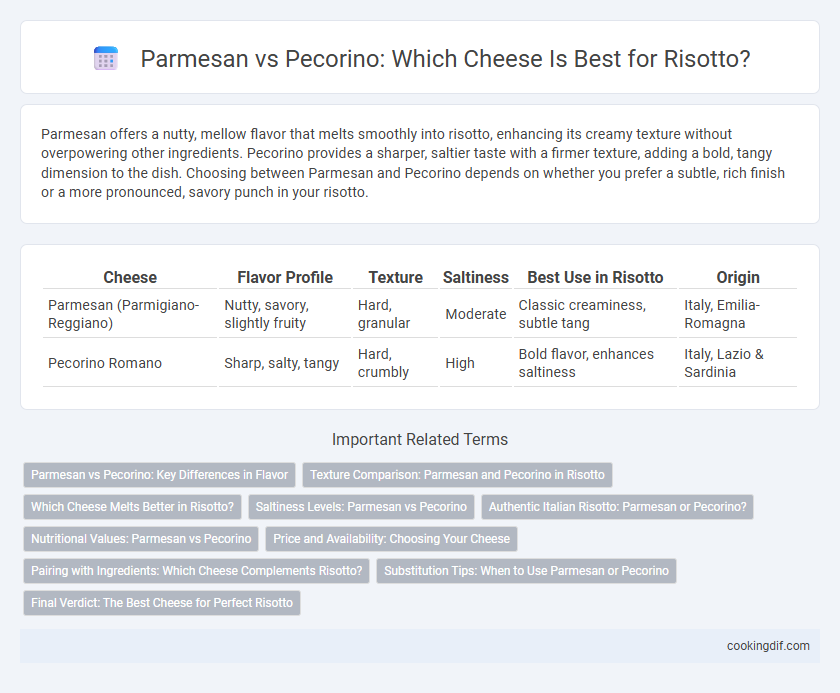Parmesan offers a nutty, mellow flavor that melts smoothly into risotto, enhancing its creamy texture without overpowering other ingredients. Pecorino provides a sharper, saltier taste with a firmer texture, adding a bold, tangy dimension to the dish. Choosing between Parmesan and Pecorino depends on whether you prefer a subtle, rich finish or a more pronounced, savory punch in your risotto.
Table of Comparison
| Cheese | Flavor Profile | Texture | Saltiness | Best Use in Risotto | Origin |
|---|---|---|---|---|---|
| Parmesan (Parmigiano-Reggiano) | Nutty, savory, slightly fruity | Hard, granular | Moderate | Classic creaminess, subtle tang | Italy, Emilia-Romagna |
| Pecorino Romano | Sharp, salty, tangy | Hard, crumbly | High | Bold flavor, enhances saltiness | Italy, Lazio & Sardinia |
Parmesan vs Pecorino: Key Differences in Flavor
Parmesan offers a nutty, savory flavor with a granular texture, ideal for enhancing risotto's creamy consistency without overpowering other ingredients. Pecorino, made from sheep's milk, delivers a sharper, saltier taste and a firmer texture, imparting a bold, tangy edge that complements robust risotto recipes. The choice between Parmesan and Pecorino depends on the desired flavor profile, with Parmesan providing subtle richness and Pecorino adding vibrant intensity.
Texture Comparison: Parmesan and Pecorino in Risotto
Parmesan cheese offers a granular texture that melts smoothly into risotto, creating a creamy consistency without overpowering the dish. Pecorino, with its slightly crumbly and firmer texture, adds a more pronounced bite and rustic element to risotto, enhancing the overall mouthfeel. Choosing between Parmesan and Pecorino depends on the desired texture balance, with Parmesan favoring smoothness and Pecorino contributing a more textured finish.
Which Cheese Melts Better in Risotto?
Parmesan melts more smoothly in risotto, creating a creamy texture that enhances the dish's richness without overpowering other flavors. Pecorino, while flavorful and sharp, tends to be saltier and less creamy, often resulting in a grainier consistency when melted. For the best melting quality and balanced taste, Parmesan is preferred in traditional risotto recipes.
Saltiness Levels: Parmesan vs Pecorino
Parmesan cheese, specifically Parmigiano-Reggiano, offers a balanced saltiness that enhances risotto without overpowering its creamy texture, while Pecorino Romano presents a sharper and more pronounced saltiness that can dominate the dish if not used sparingly. The salt content in Pecorino is typically higher, making it ideal for those who prefer a bold, tangy flavor profile in their risotto. Choosing between Parmesan and Pecorino depends on the desired saltiness and overall flavor intensity in the final risotto dish.
Authentic Italian Risotto: Parmesan or Pecorino?
Authentic Italian risotto traditionally features Parmesan cheese, known for its nutty, savory flavor and smooth melt that enhances the creamy texture of the dish. Pecorino, a sharper and saltier sheep's milk cheese, offers a bolder taste but can overpower the subtle flavors of the risotto. Parmesan's balance of umami and richness makes it the preferred choice in classic Italian culinary tradition.
Nutritional Values: Parmesan vs Pecorino
Parmesan cheese contains approximately 431 calories and 38 grams of protein per 100 grams, making it rich in protein and calcium, which supports bone health. Pecorino, made from sheep's milk, offers around 387 calories and 28 grams of protein per 100 grams, with higher sodium and fat content than Parmesan. Both cheeses provide essential nutrients but Parmesan is lower in fat and sodium, making it a leaner choice for risotto recipes.
Price and Availability: Choosing Your Cheese
Parmesan cheese is widely available and generally more affordable, making it a popular choice for risotto in many households and restaurants. Pecorino, often pricier and less commonly stocked, provides a sharper, saltier flavor that can elevate a risotto but may require sourcing from specialty or gourmet stores. Deciding between Parmesan and Pecorino depends on budget constraints and access to quality cheese retailers, balancing cost and desired taste intensity.
Pairing with Ingredients: Which Cheese Complements Risotto?
Parmesan cheese, known for its nutty, savory flavor and granular texture, pairs exceptionally well with creamy risottos featuring mushrooms, asparagus, or seafood, enhancing their subtle earthiness without overpowering. Pecorino, a sharper, saltier cheese made from sheep's milk, complements risottos that incorporate robust ingredients like sausage, kale, or spicy sausage, adding a bold, tangy depth. Choosing Parmesan or Pecorino depends on the risotto's flavor profile, balancing mild creaminess with intense, savory notes to achieve a harmonious dish.
Substitution Tips: When to Use Parmesan or Pecorino
Parmesan cheese offers a nutty, slightly sweet flavor ideal for creamy risottos, while Pecorino provides a sharper, saltier taste that enhances bolder dishes. Substitute Parmesan when seeking a milder, more balanced cheese that complements delicate ingredients like mushrooms or asparagus. Use Pecorino for risottos featuring robust flavors such as sausage or truffle, as its intense character elevates the dish's overall depth.
Final Verdict: The Best Cheese for Perfect Risotto
Parmesan offers a nutty, mellow flavor and creamy texture that melts seamlessly into risotto, enhancing its traditional Italian profile. Pecorino, with its sharper, saltier taste and firmer consistency, provides a bold contrast that complements heartier variations like mushroom or sausage risotto. For the perfect risotto balance, Parmesan is generally preferred for its subtle richness, while Pecorino is ideal when a more pronounced cheese character is desired.
Parmesan vs Pecorino for cheese Infographic

 cookingdif.com
cookingdif.com